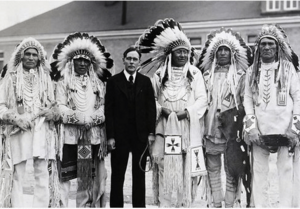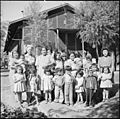Indian Reorganization Act facts for kids
 |
|
| Other short titles |
|
|---|---|
| Long title | An Act to conserve and develop Indian lands and resources; to extend to Indians the right to form business and, other organizations; to establish a credit system for Indians; to grant certain rights of home rule to Indians; to provide for vocational education for Indians; and for other purposes. |
| Nicknames | Wheeler–Howard Act |
| Enacted by | the 73rd United States Congress |
| Effective | June 18, 1934 |
| Citations | |
| Public law | Pub.L. 73-383 |
| Statutes at Large | 48 Stat. 984 |
| Codification | |
| Titles amended | 25 U.S.C.: Indians |
| U.S.C. sections created | 25 U.S.C. ch. 14, subch. V § 461 et seq. |
| Legislative history | |
|
|
The Indian Reorganization Act (IRA), also known as the Wheeler–Howard Act, was a major law passed in the United States on June 18, 1934. It changed how the U.S. government dealt with American Indians. This law was a key part of what people called the "Indian New Deal."
Its main goal was to stop the old idea of forcing Native Americans to become like other Americans. Instead, it aimed to make Native American tribes and their cultures stronger. The Act also gave Native Americans more control over their lands and resources, like mineral rights. It helped create a better economic future for people living on Indian reservations.
This law did not apply to all areas at first, like Hawaii or Alaska. It also did not apply to Oklahoma until later. However, in 1936, the rights of Indigenous people in Alaska and Oklahoma were recognized under a new law.
The Indian Reorganization Act was a big project led by John Collier. He was the Commissioner of the Bureau of Indian Affairs (BIA) from 1933 to 1945. Collier wanted to fix the problems caused by past policies that had harmed Native American cultures. He hoped to help tribes regain their independence and manage their own affairs. He also wanted to stop the loss of reservation lands and help tribes become more self-sufficient.
Contents
How did the Act change things for Native Americans?
Why was the Act needed?
Before this Act, the U.S. government had a policy to break up Indian reservations. They divided communal tribal land into small plots, usually 160 acres, for individual Native American families. This process began with the Dawes Act of 1887.
Before these changes, Native American tribes often owned land together, not as individuals. This communal ownership was part of their traditions. Non-Native Americans were not allowed to own land on reservations.
By 1934, two-thirds of Native American land had been turned into private property. Much of this land was then sold by Native American owners. This often happened because they couldn't afford to pay new local taxes on the land. The Indian Reorganization Act aimed to help tribes get some of this land back.
John Collier became the head of the Indian Bureau (now the BIA) in April 1933. He had strong support from President Franklin D. Roosevelt and Secretary of the Interior Harold L. Ickes.
The government held land in trust for many tribes. This meant the government managed the land for the tribes. However, there were many complaints because the government often did not manage these lands well, especially forests. The Indian Claims Act of 1946 later required the government to manage Native American forests carefully.
What happened after the Act was passed?
The Act slowed down the practice of dividing tribal lands among individual members. It did not take back land that was already privately owned. However, much land was still held in trust by the U.S. government for individuals or was not yet divided. Because of this, reservations today often have a mix of tribal land, individual trust land, and privately owned land.
The Act also allowed the U.S. government to buy some private land and return it to tribal ownership. In the first 20 years after the Act, more than two million acres of land were returned to various tribes.
Later, in 1954, parts of the Act were changed by Congress. These changes led to a "termination policy." This policy aimed to end the special relationship between the U.S. government and some tribal nations. It meant that 61 tribal nations lost their legal status and their members lost access to certain government programs. However, 46 of these tribes later regained their legal status.
How has the Act been challenged?
Since the late 1900s, there have been many legal challenges to the Indian Reorganization Act. These challenges often come from states or local governments. The main issue is a part of the Act that lets the U.S. government buy non-Native American land and turn it into Native American land. When this happens, the land becomes less subject to state laws. This can allow activities like casino gambling or tax-free businesses, which states might not want.
In 1995, the state of South Dakota argued that the Act was unconstitutional. They said it gave too much power to the Secretary of the Interior to take land into trust for tribes. A court agreed with South Dakota at first. However, the U.S. Supreme Court later sent the case back to the lower court. Eventually, other courts have upheld the Act's constitutionality.
In 2009, the U.S. Supreme Court made an important decision in a case called Carcieri v. Salazar. This case involved the Narragansett Indian tribe in Rhode Island. The tribe bought land and asked the government to take it into trust. The state argued that the Act did not apply to the Narragansett because they were not "under federal jurisdiction" in 1934 when the Act was passed. The tribe had only received federal recognition in 1983. The Supreme Court agreed with the state. This decision meant that the government could only take land into trust for tribes that were under federal jurisdiction in 1934.
How did tribes react to the Act?
The Indian Reorganization Act required tribes to vote on whether to accept the new law. A majority of eligible Native Americans had to approve it. There was some confusion about who could vote and how votes were counted. For example, in some cultures, not voting was seen as a "no" vote, but the rules counted it as a "yes."
In the end, 172 tribes accepted the Act, and 75 rejected it. The Navajo, one of the largest tribes, strongly opposed the Act. They had been badly affected by a federal program that reduced their livestock. Many Navajo people did not trust John Collier or the "Indian New Deal."
What is the Act's legacy?
Historians have different opinions about the Indian New Deal. Many praise John Collier for his efforts to help Native Americans. He helped protect their religious practices, got more money for reservations, and created a way for tribes to govern themselves. However, some historians say that the Act did not help much with economic growth or political structure for tribes.
Collier's reputation among Native Americans was mixed. Some praised him, while others strongly disliked him, especially the Navajo. Some experts also criticized him for not understanding the many different ways Native Americans lived.
The Indian Reorganization Act was a broad law that allowed tribes to govern themselves under federal oversight. It stopped the practice of dividing tribal lands and encouraged education. Collier believed that traditional Native American societies were better than modern American society. Some critics say he had a romantic view of Native American culture that didn't always fit reality.
The Act has helped protect communal tribal lands. Supporters of Collier say that Congress changed his original ideas, which made the Act less successful than it could have been. On many reservations, the Act also made existing differences worse between those who followed traditional ways and those who had adopted more American ways. Many Native Americans believe their traditional systems of government were better for their culture.
Images for kids



